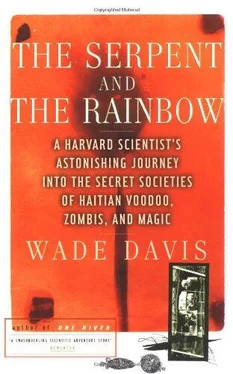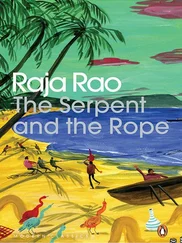Wade Davis - The Serpent and the Rainbow
Здесь есть возможность читать онлайн «Wade Davis - The Serpent and the Rainbow» весь текст электронной книги совершенно бесплатно (целиком полную версию без сокращений). В некоторых случаях можно слушать аудио, скачать через торрент в формате fb2 и присутствует краткое содержание. Год выпуска: 1985, Издательство: Simon & Schuster, Жанр: Старинная литература, на английском языке. Описание произведения, (предисловие) а так же отзывы посетителей доступны на портале библиотеки ЛибКат.
- Название:The Serpent and the Rainbow
- Автор:
- Издательство:Simon & Schuster
- Жанр:
- Год:1985
- ISBN:нет данных
- Рейтинг книги:5 / 5. Голосов: 1
-
Избранное:Добавить в избранное
- Отзывы:
-
Ваша оценка:
- 100
- 1
- 2
- 3
- 4
- 5
The Serpent and the Rainbow: краткое содержание, описание и аннотация
Предлагаем к чтению аннотацию, описание, краткое содержание или предисловие (зависит от того, что написал сам автор книги «The Serpent and the Rainbow»). Если вы не нашли необходимую информацию о книге — напишите в комментариях, мы постараемся отыскать её.
The Serpent and the Rainbow — читать онлайн бесплатно полную книгу (весь текст) целиком
Ниже представлен текст книги, разбитый по страницам. Система сохранения места последней прочитанной страницы, позволяет с удобством читать онлайн бесплатно книгу «The Serpent and the Rainbow», без необходимости каждый раз заново искать на чём Вы остановились. Поставьте закладку, и сможете в любой момент перейти на страницу, на которой закончили чтение.
Интервал:
Закладка:
Three days later, as previously arranged, we met again with Herard Simon in Gonaives. He was where he could be found every night, near the waterfront by a dilapidated movie house, his finger on the pulse of the street. His greeting this time was surprisingly cordial. Apparently my status had shifted somewhat—in what direction, I was not certain—for in place of the anonymity of “blanc” he now addressed me as his “petit malfacteur,” his little evildoer. Herard began by emphasizing that as a houngan he had no interest in zombis; they were nothing, he insisted, compared to the profound lessons of the vodoun religion. For business reasons, however, he had made the necessary arrangements. On the morrow, he promised, one of his contacts would begin to prepare the zombi powder.
“And malfacteur,” he said just before we left him, “with what I give you your monkey will go down, it will not come up, and it will never again wag its tail.”
It took a full week to make the poison.
First Herard, as houngan, prepared the antidote, which, not surprisingly, contained a plethora of ingredients, none of which had significant pharmacological activity. It consisted of a handful of bayahond leaves (Prosopis juliflora) , three branches of ave (Petiveria alliacea) , clairin, ammonia, and three ritualistically prepared lemons. As in the case of the reputed antidote prepared by Marcel Pierre, there was no evidence that it could chemically counteract the effects of any poison.
The actual poison did have potent constituents, and critically the ingredients overlapped in significant ways with those used at Saint Marc. Herard’s man distinguished three stages or degrees to the preparation. During the first a snake and the bouga toad (Bufo marinus) were buried together in a jar until “they died from rage.” Then ground millipeds and tarantulas were mixed with four plant products—the seeds of tcha-tcha (Albizzia lebbeck) , the same leguminous species added by Marcel Pierre; the seeds of consigne (Trichilia hirta) , a tree in the mahogany family with no well-known active constituents; the leaves of pomme cajou , the common cashew (Anacardium occidentale) ; and bresillet (Comocladia glabra) . The last two plants are members of the poison ivy family, and both, especially bresillet, can cause severe and dangerous dermatitis.
These ingredients, once ground to powder, were placed in the jar and left below ground for two days. Then, at the second degree, two botanically unidentified plants known locally as tremblador and desmembre were added. For the third and final degree, four other plants capable of causing severe topical irritations were mixed in. Two were members of the stinging nettle family, maman guêpes (Urera baccifera) and mashasha (Dalechampia scandens) . The hollow hairs on the surface of these plants act as small hypodermic syringes and inject a chemical similar to formic acid, the compound responsible for the pain of ant bites. A third plant was Dieffenbachia seguine , the common “dumbcane” of Jamaica. In its tissues are calcium oxalate needles that act like small pieces of glass. The English name derives from the nineteenth-century practice of forcing recalcitrant slaves to eat the leaves; the needles, by irritating the larynx, cause local swelling, making breathing difficult and speaking impossible. The fourth plant, bwa piné (Zanthoxylum matinicense) , was added because of its sharp spines.
The addition of these irritant plants recalled Marcel Pierre’s use of Mucuna pruriens , the itching pea. It was of interest that several of these additives could produce such severe irritation that the victim, in scratching himself, might quite readily induce self-inflicted wounds. I knew from the results of the laboratory experiments in New York that the powder, though topically active, was particularly effective if applied where the skin had been broken. Mme. Jacques had suggested that ground glass might be used. And of course I had reason to believe that when the powder was administered the skin of the victim was quite deliberately broken. It had been stated that the powder might be applied more than once, so it was possible that the irritant plants directly increased susceptibility to subsequent doses.
It was the list of animals added at the third degree that gave me the greatest sense of satisfaction. Tarantulas of two species were ground with the skins of the white tree frog (Osteopilus dominicencis) . Other ingredients included another bouga toad and not one but four species of puffer fish (Sphoeroides testudineus, S. spengleri, Diodon hystrix , D. holacanthus) . Thus, in common with the poison prepared by Marcel Pierre, we had the toad, the puffers, including the sea toad, and the seeds of Albizzia lebbeck .
Over the course of that week our relationship with Herard Simon warmed considerably. There was no one dramatic turning point, as there had been in the case of Marcel Pierre; Herard was far too clever and wary for that. Rather, it was a number of small incidental things that he appreciated—the fact that we drank from his well, that we shared his plate, that we curled up beside him on the stony ground.
For one reason or another, in time, he chose to loose three critical pieces of information. First, he gave me the names of four preparations used to create zombis— Tombé Levé, Retiré Bon Ange, Tué , and Levé— and though he refused to describe the specific formulae, he did offer the facts that one killed immediately, another made the skin rot, and a third caused the victim to waste away slowly. He also commented that these virulent preparations had one ingredient in common—the crapaud de mer, the most toxic of the puffers found in Haitian waters.
Secondly, Herard told me that the best powders were made during the hot months of the summer, and were then stored and distributed throughout the year. At the same time, he cautioned that some of these were excessively “explosive,” that they killed too completely. From the research I had done in Cambridge I knew that levels of tetrodotoxin within the puffer fish are not consistent. They vary not only according to sex, geographical locality, and the time of the year, but from individual to individual within a single population. A puffer from Brazilian waters, Tetrodon psittacus , for example, is only poisonous in June and July. Among Japanese species toxicity begins to increase in December and reaches a peak in May or June. The species used in the zombi preparations show a similar pattern— Sphoeroides testudineus , the sea toad, is most toxic in June, precisely the time when Herard said the poison was strongest.
Finally, Herard told us that when the zombi is taken from the grave it is force-fed a paste, with a second dose administered the next day when the victim reaches its place of confinement. The ingredients of the paste were three: sweet potato, cane syrup, and, of all things, Datura stramonium .
It was a startling piece of information. Since the beginning of the investigation, the role of this potent psychoactive plant, so suggestively named the zombi’s cucumber in Creole, had eluded me. Now a dozen incongruous facts crystallized into an idea. So far the search for a medical antidote for the zombi poison had turned up nothing of pharmacological interest. Each zombi powder had its locally recognized “antidote,” but in each case the ingredients were either inert or were used in insufficient concentration. Moreover, there was no consistency in either their constituents or the means of preparation between the various localities. Now, with Herard’s revelation, I had reason to believe that if there was an actual antidote, it was the zombi’s cucumber!
Читать дальшеИнтервал:
Закладка:
Похожие книги на «The Serpent and the Rainbow»
Представляем Вашему вниманию похожие книги на «The Serpent and the Rainbow» списком для выбора. Мы отобрали схожую по названию и смыслу литературу в надежде предоставить читателям больше вариантов отыскать новые, интересные, ещё непрочитанные произведения.
Обсуждение, отзывы о книге «The Serpent and the Rainbow» и просто собственные мнения читателей. Оставьте ваши комментарии, напишите, что Вы думаете о произведении, его смысле или главных героях. Укажите что конкретно понравилось, а что нет, и почему Вы так считаете.












